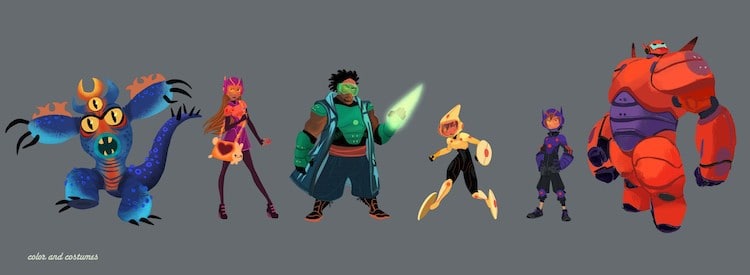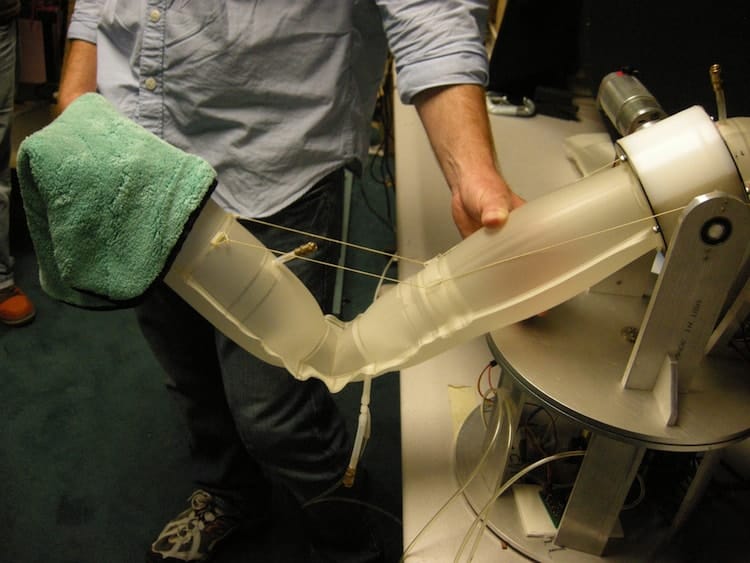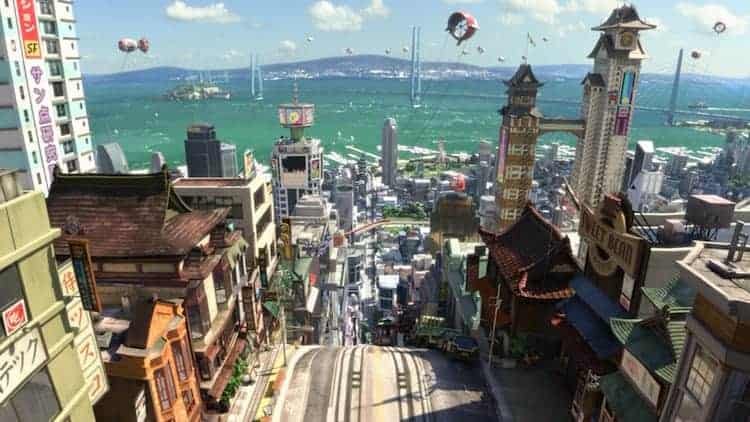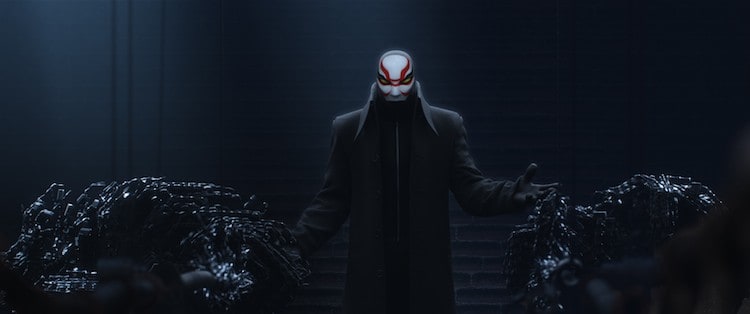A few months ago I had the chance to visit the Disney Animation Studios and talk with Directors Don Hall and Chris Williams of Big Hero 6. They went into great length about what it took to transform the little known Marvel comic into the upcoming Disney Animated Feature. From researching cutting edge robotic technologies to the casting process and even erecting a new city —“Welcome to San Fransokyo” — the filmmakers gave some insight into what it took to bring Big Hero 6 to the big screen.
 Very early on the filmmakers knew that technology would play a huge part in the world of Big Hero 6. At the center of the story is the ‘microbot,’ an invention created by robotics prodigy and central protagonist, Hiro. Inspired by what was observed at the robotics labs at MIT and Carnegie Melon, the microbot is a telepathically manipulated mini-robot that works in tandem with millions of other microbots to construct, shape, and function itself as a physical extension of its controller. What’s really astonishing, as the creative team discovered, is that in the time that filmmakers began working on Big Hero 6 (about 3 years ago) up till now, mind controlled robotic devices (such as prosthetic arms) have actually come to fruition. That just goes to show how fast technology is changing and its kinda neat that a Disney film is so forward-thinking. One area where these technologies played a significant role was in the development of the character Baymax.
Very early on the filmmakers knew that technology would play a huge part in the world of Big Hero 6. At the center of the story is the ‘microbot,’ an invention created by robotics prodigy and central protagonist, Hiro. Inspired by what was observed at the robotics labs at MIT and Carnegie Melon, the microbot is a telepathically manipulated mini-robot that works in tandem with millions of other microbots to construct, shape, and function itself as a physical extension of its controller. What’s really astonishing, as the creative team discovered, is that in the time that filmmakers began working on Big Hero 6 (about 3 years ago) up till now, mind controlled robotic devices (such as prosthetic arms) have actually come to fruition. That just goes to show how fast technology is changing and its kinda neat that a Disney film is so forward-thinking. One area where these technologies played a significant role was in the development of the character Baymax.
 Baymax “just sort of evolved out of the vinyl…inflatable, soft robotics” that the filmmakers encountered during their research. Since he is such a prominent and central character, the filmmakers were all really attracted to what Baymax could be. They knew what a special character they had, as Director Don Hall commented, “[Baymax represents] this idea of a newborn thing…experiencing the world for the first time. He is so simple and so good and so selfless and so guide-less” that he provides a great aspirational quality for the audience. He continued, “wouldn’t we all like to be as selfless and good as Baymax?” After seeing the character sketches and test footage for Baymax, the answer was an emphatic, “yes.”
Baymax “just sort of evolved out of the vinyl…inflatable, soft robotics” that the filmmakers encountered during their research. Since he is such a prominent and central character, the filmmakers were all really attracted to what Baymax could be. They knew what a special character they had, as Director Don Hall commented, “[Baymax represents] this idea of a newborn thing…experiencing the world for the first time. He is so simple and so good and so selfless and so guide-less” that he provides a great aspirational quality for the audience. He continued, “wouldn’t we all like to be as selfless and good as Baymax?” After seeing the character sketches and test footage for Baymax, the answer was an emphatic, “yes.”
Once the design and look of Baymax was finalized, it was interesting to hear how they found Scott Adsit to voice the character. Mr. Adsit is probably most well know for his role as Pete Hornberger, TGS’s head writer on NBC’s ’30 Rock.’ As all the characters were in the early development phases of storyboarding and screenings, the casting department started putting together a list of performers that they felt would best represent the characters. Now during this time the animators would use someone internally (most likely a fellow animator) to provide a temporary or “scratch” voice. Just as a sidenote: it’s not uncommon for the scratch voice performers to end up being the final voice. For instance, Big Hero 6 director Chris Williams ended up providing the final voice of ‘Oaken’ in Frozen. For Baymax, the process was no different and even though the scratch voice wasn’t the final voice used, he did help the directors understand what he was gonna be like and sound like. So later, when they found Scott Adsit, “It’s was like boom, that’s it!” Furthermore, the Directors noted that what Scott was able to pull off “within such a narrow tonal band” just blew them away.
 The conversation then moved onto the fictional metropolis of San Fransokyo and how it came about. The animators explain that before they really solidify any story they like to first craft the world because often the environment of the story can inform the action. Right from the get-go, they knew they wanted a Japanese aesthetic but didn’t want to set the story in the real world. What was really appealing was the idea of mashing things up. As the Marvel/Disney mash up started to permeate the process, they explain that idea of mashing up two cities became very intriguing to them. “Tokyo was the obvious one.” As for why they chose San Francisco? “It just seemed cool because it’s got a lot of landmarks that you can put a Japanese esthetic over.” One striking feature I am eager to learn more about are the giant inflatable turbine fan-kites. “It’s electricity for the future, it’s all super tech. It kind of had a Miyazaki flavor to me” they say. Perfect answer.
The conversation then moved onto the fictional metropolis of San Fransokyo and how it came about. The animators explain that before they really solidify any story they like to first craft the world because often the environment of the story can inform the action. Right from the get-go, they knew they wanted a Japanese aesthetic but didn’t want to set the story in the real world. What was really appealing was the idea of mashing things up. As the Marvel/Disney mash up started to permeate the process, they explain that idea of mashing up two cities became very intriguing to them. “Tokyo was the obvious one.” As for why they chose San Francisco? “It just seemed cool because it’s got a lot of landmarks that you can put a Japanese esthetic over.” One striking feature I am eager to learn more about are the giant inflatable turbine fan-kites. “It’s electricity for the future, it’s all super tech. It kind of had a Miyazaki flavor to me” they say. Perfect answer.
 At this point, there hadn’t been much mention at all of the film’s villain. One of the things that Marvel and Disney have in common are the big iconic villains. Aside from a quick glimpse of a man in a Kabuki mask who certainly looked treacherous and scary, he was still very much an enigma. Unfortunately that was all I was gonna get to see because the creative team remained mum about the character despite my questions. They said that since much of the plot revolves around uncovering the mystery of who the villain is, they don’t want to ruin any surprises. But they did speak generally and say that the best film villains are, in their own minds, the hero of their own story.
At this point, there hadn’t been much mention at all of the film’s villain. One of the things that Marvel and Disney have in common are the big iconic villains. Aside from a quick glimpse of a man in a Kabuki mask who certainly looked treacherous and scary, he was still very much an enigma. Unfortunately that was all I was gonna get to see because the creative team remained mum about the character despite my questions. They said that since much of the plot revolves around uncovering the mystery of who the villain is, they don’t want to ruin any surprises. But they did speak generally and say that the best film villains are, in their own minds, the hero of their own story.
And on that note, I gave my thanks and was left to ponder who the villain might be. All will be revealed when I check the film out when it’s released in theaters on November 7th.
How did I miss that this was a Marvel comic? Thank you for sharing this Kean. I am a pretty big fan of any Marvel, so I’ll need to give this movie an actual try!
Technology is amazing! Very interesting to learn about. Thanks for sharing your experience, sounded like a lot of fun!
Sounds like a wonderful and informative trip. The movie making process is so in depth! It would be fun to see this process someday in detail.
Neat graphics. It is amazing to me how much detail goes into animated films. I am looking forward to taking my son to see this film.
It sounded like you had an amazing time and adventure indeed. It is so interesting from start of the movie to the end. I would so love to visit there some day. Thanks for sharing.